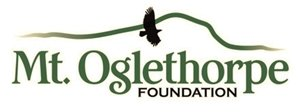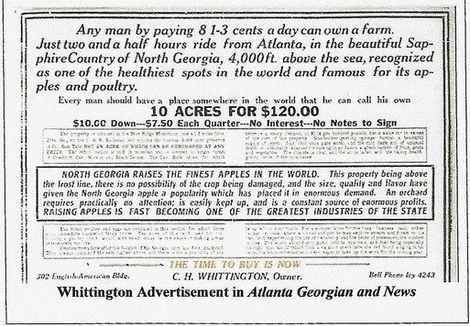The Old Dude Ranch
The Early Days Before Bent Tree - Part 1
By: Don & Diane Wells
Having either received land in the Georgia Land Lottery of 1832 or purchased it from those who had, pioneers began moving into the area of what is now Pickens County after the Cherokees were removed and sent west to Oklahoma on the Trail of Tears in 1838. Griffith, Tate, Champion, West, Padgett, Pendley, Pettitt, Darnell, Fields, Mullinax, Hendrix and others were early pioneer family names that are still recognized today Collectively they might be referred to as the mountain people since they moved into the hills, hollers and mountain ridges of Grassy Knob, known today as Oglethorpe Mountain. Some were Scotch Irish, some English, some French and some from other heritages. They were all self-sufficient people who could make a living in the mountains, doing whatever was needed to make ends meet. Throughout the 1800’s and into the early 1900’s these hardy souls occupied the region.
Gradually most of them became related through marriage. Changes in lifestyle began as the railroad moved into the area bringing new industries and the Marble companies begin mining that valuable resource. Some of the mountain folks began selling their land holdings and moving down to where jobs could be found. Some were able to continue to pay the taxes on their land, but others could not. Sam Tate was one who acquired many acres of mountain land in tax sales. The first major acquisition of Grassy Knob was by John Hendrix and his relatives, John and Joshua Darnell. They had traveled to Californian during the gold rush in 1849. Having found gold they returned to the mountains to buy up thousands of acres at $0.25 an acre. Part of this land is where Bent Tree is now located. Hendrix Mountain is named for John Hendrix. At the start of the 20th Century, the area of Grassy Knob, Hendrix and Mole Mountains was sparsely populated with few roads. By 1910, that all began to change. In 1911, Charles H. Whittington from Fulton County was one of the first “outsiders” to buy up property in the area of what is now Bent Tree. Part of the land he acquired was purchased from that previously purchased by John Hendrix and his Darnell relatives. Whittington purchased 380 acres from Charles Darnell in January. At that same time he also purchased 1,355 acres from Levi Darnell. The Darnell land sold for a little over$10.00/acre. It is reported that his wife, Laura, was in poor health. Thinking that the clean, clear, mountain air would be good for her, Charles built a mansion which later became known as the Dude Ranch. Lillie Mae Pendley, whose father began working at the Dude Ranch when he was thirteen years old, and where she visited many times as a child, described it as a place full of wonders. She said that it was very large. The living room was 40 feet by 40 feet with an enormous fireplace that could hold an 8 foot log. She went on to say that there were fourteen rooms, and a porch that was fourteen feet wide and high off the ground. There were six showers and two indoor toilets! Water was gravity fed down the mountain from Buck Skull Springs in order to provide continually running water in the house. Lillie Mae remembers there being a Monark stove in the large kitchen where meals were prepared. Some of the early Monark stoves had a side unit through which pipes ran to heat water which was stored in a tank. She remembers there was a large tank behind the stove. Gas lanterns provided light. There were servant quarters in the house who undoubtedly handled the meal preparation and cleaning. In addition to the main house there was a guest house called “Twin Oaks.” Lillie Mae said that the house was a sight to see for those who lived on the mountain and had very little, most of whom lived in small one to two room cabins. In Pickens County in the early 1900’s there were other large and impressive homes such as the Pink Marble house in Tate and the Henry Dewar house in Nelson. These mansion, however, were built on main roads and near towns. The Whittington place, way back up in the hills on a dirt mountain road was different. Just getting the building materials, fine furniture and other items into the site must have presented many problems. One would assume that a spectacular mansion such as the Whittington’s would have attracted the Pickens Progress to write a story and publish a picture about it but nothing has been found. The Pickens County Heritage Book has no pictures of the Dude Ranch either although some information is available and no relatives have been located that might have known more about the Dude Ranch.
The ink wasn’t even dry in the court house records when he began offering land at $12 an acre, which he was in the process of buying at $10 and acre. Mr. Whittington bought 3,880 acres in January 1911 in what is now Bent Tree and the Grassy Knob District and later bought another 235 acres. This land adventure would seem to have been rather risky and later it proved to be so. Charles Whittington, however, was in the high risk land speculation business. The June 7, 1910 issue of the Atlanta Georgian and News reported that Charles Whittington was named Cuban Consul to Atlanta and that he was Secretary/Treasurer of the Aurora Colony Company and the Guarantee Live Stock Company. The Aurora Colony Company was selling land in Cuba for $1,500 for five acres with the speculation that you could get a return of $3,000 per year from fruit sales on your land. The Guarantee Live Stock Company also was involved in land dealings in Cuba.
READ MORE ABOUT...
The Early Days before Bent Tree – Part 1 > The Old Dude Ranch


